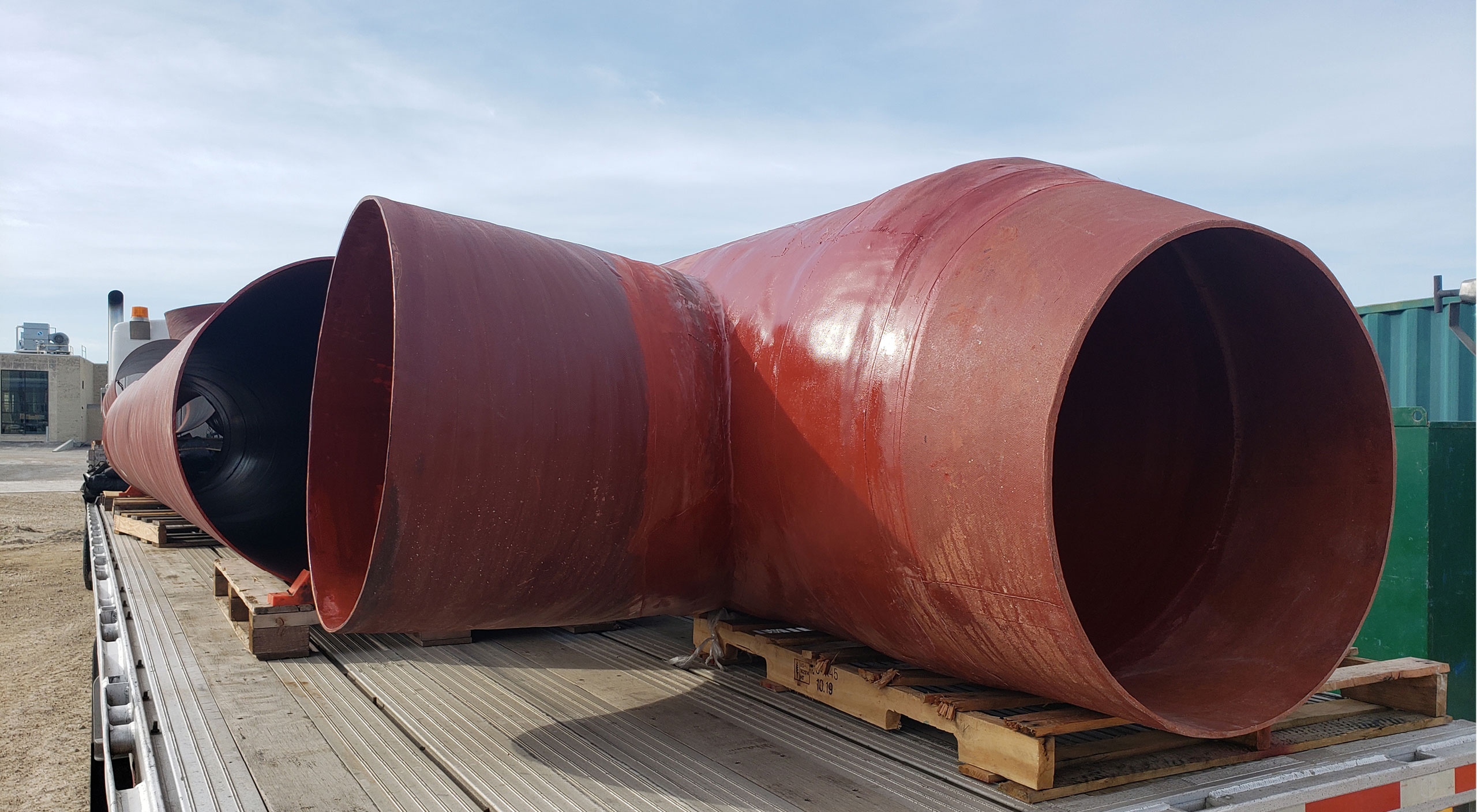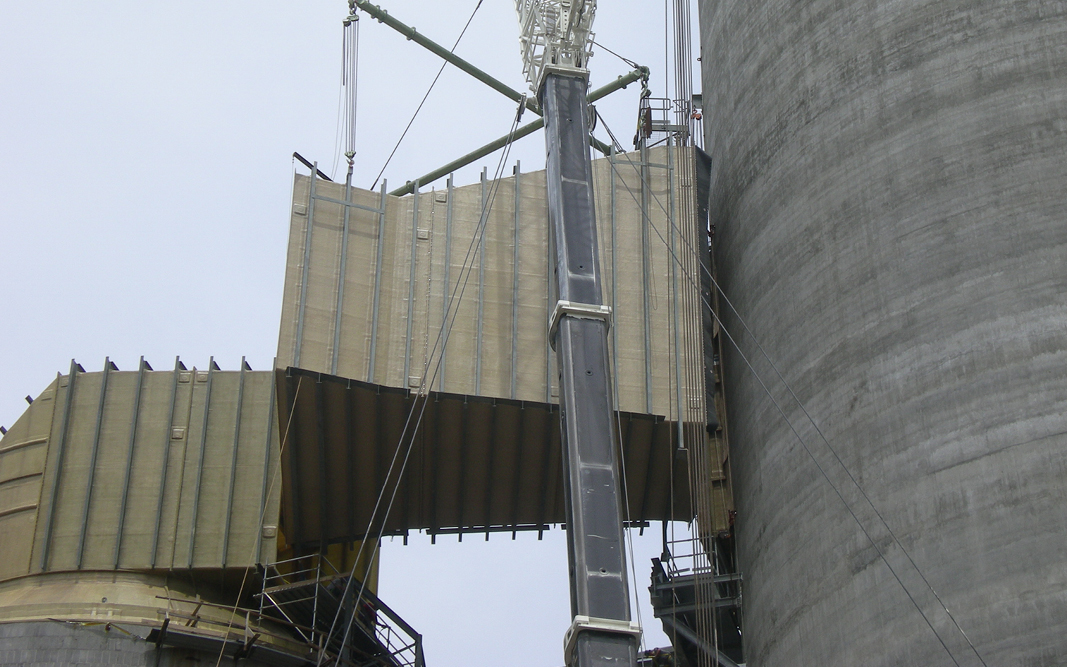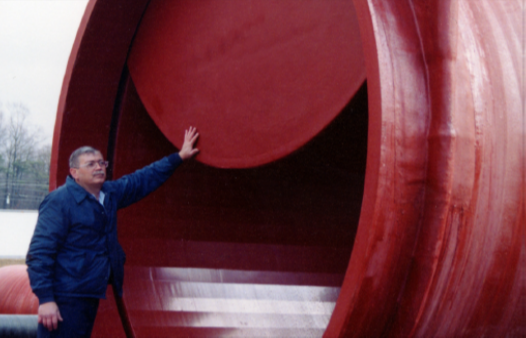Revolutionizing Ventilation
Stacks
Fiberglass Stacks
Fiberglass stacks can be manufactured and installed in much the same way as steel stacks. The advantages of fiberglass stacks are similar to the advantages of other fiberglass products: corrosion resistance, lightweight -leading to lower installation costs and ease of maintenance among the primary benefits.
Composites USA has manufactured and installed fiber[1]glass stacks for years. Some examples of our stacks are shown on this and the following pages.
Stacks can be freestanding or laterally supported. There are many possibilities available for base mounting design. Similarly, there are many ways to laterally support stacks if desired. The most common options for lateral support would include guying with wires or bolting to adjacent structural steel. With a description of the design criteria and constraints im[1]posed by the physical location of the stack, Composites USA can offer a P.E. stamped design solution.
In addition to designing the stack structural requirements, Composites USA can also offer design guidance and installation options for ladders, platforms, sampling, inspection, access ports, grounding systems, and, if required, FAA markings and warning lights.
Stack Design Considerations:
Proper stack design begins with an understanding of the process exhaust stream (volume, corrosiveness, temperature, flammability), local environmental re[1]quirements (height requirements, sampling require[1]ments), local and regional building code requirements (height requirements, wind, seismic, snow loads), and desired geometry (gas entry, base configuration, lateral support).
The strength-to-weight ratio and corrosion resistance of fiberglass-reinforced plastic make it an ideal construction material up to the temperature limits of the resin (250 – 350°F, depending on resin and service).
In general, the stack must first be designed for the process and then designed mechanically and for accessory requirements. The process will dictate location and size. The mechanical analysis will take into account loads contributed by the stack dead weight, seismic and wind loads, buckling and bending moments, guy wire compression, and temperature gradients, to name a few. A brief discussion follows:
Location:
The location, size, and configuration of the surrounding buildings and topography greatly influence the stack’s location and height.
Airflow over a building creates a positive pressure zone on the upstream side and a negative pressure zone or cavity on the roof and downstream side. Although the contour of these zones will remain relatively stable as the wind velocity changes, the contour zone and cavity envelopes can be erratic in shape due to wind turbulence.
High stack discharge velocity and temperature increase flume height and, thus, effective stack height. This, in turn, aids in the dispersion of stack contaminants, reducing ground-level concentrations. The effective stack height is the sum of the actual stack height, the plume rise due to the exhaust velocity, and the buoyancy rise, which is a function of the temperature of the exit gases and the atmospheric conditions.
Wind flow over stacks creates negative zones and eddies behind the stack, like airflow around buildings. Low stack discharge velocities permit the effluent to be drawn into the stack eddy zone and may cause a downwash. This reduces the effective stack height and may cause the effluent to enter the building cavity, even though the discharge may be well above this cavity.
The stack-to-wind velocity ratio should be at least 1.5 to 1. Under these conditions, the effluent will break cleanly from the stack, downwash will be eliminated, and the effective stack height will be maximized. In most cases, a stack discharge velocity of 3,000-4,000 feet per minute will provide good performance.
The guidelines above are satisfactory in most cases. However, federal, state and local environmental and zoning agencies may dictate stack height and location. In some cases, Federal Aviation Agency (FAA) regulations will govern some aspects of stack location or configuration. See the photograph on the first page for a view of FAA stack markings.
Wind & Seismic Loads:
Wind loads are calculated according to ASCE guidelines. Seismic loads are calculated according to the applicable local building codes (BOCA, SBBA, or ICBO in the U.S.). These form the basis for the mechanical designs. The deflection at the top of the cantilever is limited to length (inches) / 180 per the SPI’s recommendations. This is usually confirmed by finite element analysis of the stack so local reactions and bending moments can be determined.
Stack Lateral Support:
Stacks may be designed either for free-standing, with all lateral support provided by the main stack support (i.e., base flange or lugs) and stack shell, or with a combination [1]tion of base and side lateral support. Side lateral sup[1]port may consist of guy wires, hard connections to buildings or structural steel, or some other similar method. Using lateral supports can often simplify the stack and stack base design, but this is not always the case. An analysis of the design conditions and stack geometry will often need to be done with and without lateral support to determine the most economical over[1]all approach.
External stiffeners may need to be added to the shell to help resist buckling. An analysis of all forces acting on the stack will determine these requirements. Guy wires, when used, are recommended as stainless steel aircraft cable, set at an angle of 45°.
Stack Dynamic Analysis:
Vortex shedding occurs at the sides of the stack and causes force transverse to the wind flow direction. The stack dimensions determine the critical wind speed conditions at which a stack may resonate. The stack may require aerodynamic devices such as strakes or a shroud to disrupt the formation of vortices or damping devices to absorb the dynamic energy.
Stack Base:
Exhaust stacks are manufactured in a wide variety of configurations and supported in just as many ways. Stacks may be open with bottom entry or closed bottom with side inlet. Depending upon the stack size and physical constraints of the installation, they may be designed for support at the base or along the sidewall.
If an open-bottom design is chosen, the choice usually comes down to supplying either a flange or a plain (raw) end. If a flange style is chosen, the stack could be supported off the flange. Open base stacks are generally chosen where short stack sections are required to mount directly off the top of a piece of equipment, such as a fume scrubber, or of the discharge of a vertical discharge fan.
Closed base stacks may be supplied with mounting lugs similar to those supplied on process tanks or with flanged bases. Flanged bases, in turn, may be supplied as stand-alone drilled flanges, gusseted flanges, or double-flanged bases with gussets.
In all cases, the stack base will be designed for the appropriate number and size of hold-down bolts by first calculating the maximum overturning load. Using this value in combination with the stack diameter, the load-carrying requirement for each bolt can be determined. Iterations may be performed with varying numbers of hold-down bolts to achieve an optimum balance of size vs. number of bolts and spacing on the concrete pad. In all calculations, no value is assigned to the bolts in compression on the downstream side of the neutral axis (opposite the wind). The entire load is divided among the bolts considered to be in tension.
In a similar manner, the base flange or hold-down lugs are designed to satisfy the appropriate tension or compression loads imposed by the specified wind loads. Calculations for base flange thickness are modeled on relationships and equations specified in ASME RTP-1, ASME Section X, and other relevant codes.
Stack Sampling:
Sampling ports are quite often installed on stacks to provide measurements for mandated emission testing. Two ports, installed at 90° to each other, are located eight to ten stack diameters above bends or inlets and at least two stack diameters below the stack exit. Sample ports can be any size but are typically 3″ or 4″ in diameter with flanged or threaded ends, with blind flanges or plugs as appropriate.
Access Platforms:
Access to sampling ports can be off adjacent building steel, if available, or off a platform and ladder supplied and installed with the stack. Platforms are designed per the requirements of OSHA and building codes. Three rails (top, mid, toe) systems with a minimum 3′-0″ wide grating platforms are typically supplied. Support clips off the stack are designed and reinforced for loads imposed. Access to the platform can be by a ladder, caged per requirements, or supported off the stack. Materials of construction for ladders and platform systems can be fiberglass (as shown), steel, or alloy.
Corrosion Requirements:
Stack construction materials need to be evaluated for long-term performance with the anticipated corrosive contaminants at temperature. Generally speaking, most fiberglass resin materials used for tanks and piping will also perform very well for stacks. Additional guidance in this area can be obtained from any of several published corrosion tables, including the one at the end of this design guide.
Flammability:
All stacks should be manufactured using fire-retardant materials. Many fiberglass materials have been tested and classified per the ASTM E-84 tunnel test. Many resins have successfully demonstrated a Class 1 flame resistance (measuring <25 with red oak = 100 and concrete = 0) by the measurements of this test. Every effort should be made to use one of the resins.
Consideration should be given to installing a liquid flush or sprinkler system. This is particularly true if large cake or dust deposits tend to build up in the stack, oxidizing substances such as sodium chlorate or potassium permanganate can be deposited on the wall, or process upsets can produce a potentially combustible gas stream.
Electrical Conductivity & Lightning Protection:
Lightning bolts seek the path of least resistance. Depending on the stack size and location, a lightning protection system might be considered. If desired, Composites USA can factory supply and install the points, conductors, fasteners, air terminals, joints, and ground.
Aircraft Warning:
Aircraft warning bands or lighting may be required or advisable for tall stacks. These may be supplied and installed at Composites USA in full accordance with FAA requirements. Where supplied, lighting systems are provided with manual or electric cabling and winch systems to allow service from ground level.
Condensate Handling & Maintenance:
Stack gases are very often saturated vapors. It is common for stack gases to cool and condense these vapors into a liquid condensate while operating. In addition, driving rains can often allow water into the stack from above. Drain connections are usually installed in closed bottom stacks for both reasons. Some stacks incorporate a sloped bottom, similar to those on some storage tanks, to facilitate full drainage.
Access to the base of the stack for periodic inspections and maintenance is recommended. Inspection ports can take the form of flanged and bolted manways or flush-mounted covers with hinged and lockable doors.
Rain caps of various styles are often incorporated to minimize liquid entering the stack (rain, snow). In addition to rain caps, drip rings are sometimes incorporated to catch and channel any stack condensation down to the base of the stack and out of the plume.
Finally, where considered necessary, stack-back draft dampers may be installed to prevent unwanted air from being drawn from outside through non-operational fans or process equipment.
Why Composites USA?
Since 1982, Composites USA has continued to execute the demands of many of the world’s most discerning and demanding users. From intricate and complex parts to multi-million dollar design/fabricate/construct schemes, we invoke hundreds of years of combined experience and technological superiority in each and every initiative undertaken. With industry recognized Approvals and Listings from Factory Mutual, Underwriters Laboratories, and the U.S. Government, Composites USA is well positioned to be your sole source provider for reinforced plastic needs.
Call Composites USA for Design Assistance & Recommendations for Your Stack!
Literature & Specification Sheets
Latest Technical Articles
Maximizing Cost Savings: The Impact of DualGuard FM UL Approvals
Uncover how DualGuard FM UL approvals revolutionize cost-effectiveness. Discover key insights on maximizing savings through cutting-edge technologies. Elevate your safety standards while optimizing financial efficiency.
Elevating Safety in Corrosive Environments: The Game-Changing Power of FlameGuard E84 Low Flame Ducting
Dive into the revolutionary world of FlameGuard E84 Low Flame Ducting. Uncover how this innovation reshapes safety standards in corrosive settings, ensuring optimal protection and peace of mind.
Revolutionizing Industrial Safety with DualGuard UL & FM Listed Firesafe Ducting
One of the latest innovations leading this charge is the DualGuard UL & FM Listed Firesafe Ducting from Composites USA. This advanced ducting system is designed to provide unparalleled fire safety and reliability in demanding industrial environments.
Contact Us




